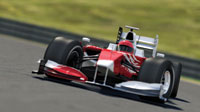
Posted to News on 18th Oct 2017, 00:00
Can Formula One technology benefit your own processes?
Behind Formula One motorsport is an industry steeped in the ethos of overcoming challenges, finding better solutions and embracing continual improvement, fully supported by the technology and manufacturing expertise to realise these goals. Transfer of this approach to other sectors, especially in defence, marine and aerospace, brings significant benefits.

The synergies between motorsport and the defence sector may not be immediately apparent, but dig deeper and opportunities arise for transferring some of the thought processes and techniques. Take, for example, military vehicles; minimising time out of commission is the equivalent of a lengthy pit stop in motorsport. The F1 approach would be to engineer a quicker solution capable of getting the car back on track as soon as possible. The military answer is often to discard the troublesome vehicle and use another, effecting repairs at a later date probably back at base, resulting in the vehicle being out of action for some time. Could some of the techniques used to keep F1 cars racing be used to advantage in this aspect of the military arena, increasing effective utilisation and the time available for the vehicle to be fully operational?
This is a real example where transfer of connection technology developed by Staubli in the motorsport arena has been used to advantage in another sector. Panther reconnaissance vehicles were increasingly suffering mechanical damage due to being used in the hot, stony hostile environment of the Middle East, significantly restricting the availability of these vehicles in the field. To provide an effective and easy to implement solution, quick release connectors were fitted to the air conditioning and radiator assemblies. These non-spill clean break connectors made it possible for the complete condenser and radiator sub assembly to be quickly removed from the vehicle and replaced without any need to de-pressurise, purge and recharge the refrigerant in the system. An operation that would normally take 2½ hours and often require a return to base was reduced to just 30 minutes and could be performed in the field.
The use of quick release connectors, like those used on F1 cars, on military vehicles has provided a safe and secure method of disconnecting and re-connecting essential liquid and gas lines. No draining or refilling is necessary enabling faster maintenance without the need for specialist tools, equipment or training.
Vehicle air-conditioning circuits used for personnel cooling are critical in the hot arid climates of operation and cannot be compromised. Using Staubli’s refrigerant couplings, high integrity leak free connection points provided a simple solution for breaking cooling lines, ensuring reliable operation and maintenance without spillage of ozone depleting gasses, or inclusion of dirt into the system. Applications for this innovative connection technology are now also being found in the aerospace and electronics markets.
Back at the racetrack what other considerations commonplace to F1 engineers could be adopted by other sectors? Motorsport embraces the continual need to improve, gain competitive advantage and perform reliably under some of the most severe operating conditions. These are all considerations that should also be in the minds of those operating in other market sectors. The initial design of the product at the OEM stage is the starting point; can the design be adapted to improve performance and reliability, make maintenance and servicing easier, faster, and even unnecessary?
Perhaps the synergies between motorsport and the aerospace sector are more readily apparent. After all, aerodynamically a race car operates as an aeroplane in reverse, creating an incredible amount of downforce. There are manufacturing similarities between aerospace and motorsport; top-end motorsport uses aerospace-grade metals and advanced metrological inspection. Over 80% of an F1 car’s volume is made from composite materials; its advanced use in aerodynamic and structural components has been the norm for over two decades. This expertise is increasingly in demand in the aerospace sector where composites are replacing metals and providing operational advantages in many applications.
Parallels between motorsport and marine industries are also numerous, not least because both sectors are involved in sporting activities which serve as a proving ground for innovative new technologies. Offshore powerboating is one, more obvious, example of marine motorsport technologies. As in a single-seat racing car, boats competing in the Powerboat P1 World Championship use carbon fibre hulls as their main structural part. Similarly, aerodynamic and hydrodynamic performance is optimised using motorsport-developed Computational Fluid Dynamics (CFD).
The Motorsport Industry Association (MIA) has a central role in this transfer of skills, expertise and style of approach. It has established initiatives bringing together companies in the defence, marine, aerospace and automotive sectors with those operating in motorsport using products and techniques that potentially could have applications in these other sectors.
Nick Wills appointed Defence Development Director for the MIA in 2014 after a successful career in the Army commented: “Maintaining complex equipment at war is a significant challenge faced by all three services, be that in the land, air or sea environments. Equipment failures can lose battles and ultimately lives, and so the transfer of technology from a cutting edge sector such as motorsport in order to increase the battlefield serviceability and availability of warfighting platforms is highly attractive to defence sector companies.
“The capability that the connectors from Stäubli provide will ensure that, if fitted, the equipment is the favoured choice of the defence maintenance and engineering communities. To have motorsport-proven technology that reduces the need for strict engineering hygiene, speeds up the procedures, and saves resources through no loss of fluids or gas, is a game changer for those at war. I am convinced that Stäubli connectors are facing a considerable market opportunity in the defence sector.”
















